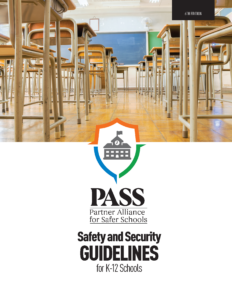What is weapon detection technology, and how can schools leverage it to keep kids safer? Download our white paper to get the answers.
Top technology experts collaborated with PASS to develop a white paper for schools and districts, enabling them to better understand and implement weapon detection technology.
The white paper provides insights in the following areas:
- Definition of weapons detection technology
- How the technology fits into the “Deter, Detect, Delay, Response” approach to safety and security
- What expectations and process requirements are needed to implement weapons detection
What is weapon detection technology?
Weapon detection technology is categorized in several ways, including:
- Physical – walkthrough (primary) and hand wand (secondary) detectors
- Magnetometers (passive metal detectors for ferrous metals that can be magnetized)
- Metal weapons detection system (active metal detectors that can differentiate between ferrous and nonferrous metals and distinguish shapes of the metallic objects)
- Audio (gunshot detection)
- Sound and infrared analysis (only after the fact)
- Visual (video surveillance analytics)
- Brandished weapon detection
- X-ray detection
As with any security system, each of these systems has advantages and disadvantages. This paper explores how and where schools can implement these systems. While there are additional technologies that can address explosive devices, this paper is more focused on firearms and large mass casualty metallic objects, as these are the most relevant for schools today.
How does weapon detection technology fit into the PASS “Deter, Detect, Delay, Response” approach to safety and security?
Industry experts in weapons detection conclude that different technologies fit the matrix in distinct ways. The paper details how each weapon detection technology fits across various areas of the “Deter, Detect, Delay, and Response” matrix. For example, some technologies play a role at each stage, while others are prominent only at the “Detect” stage.
What are the expectations and process requirements for weapons detection in K-12 schools?
Schools and districts should begin by establishing a baseline expectation of what the school or district requires from the technology. PASS recommends that schools should reasonably expect that firearms and larger, tactical knives will be detected and not allowed in the building. This is the true road map, and we cover a lot of detail in this section of the white paper.
How should K-12 schools evaluate weapons detection technologies?
When evaluating weapon detection systems, there are several testing criteria that schools should be aware of. The white paper presents and explains nine recommendations to facilitate a thorough evaluation of the systems, including validation testing, screening time, nuisance alerts, alarm resolution, and other key aspects.
Are there special considerations for the operation and maintenance of weapon detection systems?
There are many, including training and testing, entry point staffing, cleaning, and system updates. Our white paper provides an in-depth analysis, culminating in a section on “Unification of Weapon Detection Technologies.”
Ready to learn more and make a weapon detection plan for your school?
The threat of a mass casualty incident in a school is a great cause for concern, and implementing weapons detection technology needs to be a strategic, layered approach. The keys to evaluating and implementing technology include setting appropriate expectations for the process and technology, understanding and identifying threats specific to the school and/or district, and implementing proper operational procedures.
By focusing on a layered and tiered approach to mitigate the risk of mass casualty weapons entering the school campus and/or building, setting appropriate expectations, and investing time to train the personnel on the processes and technology, schools can successfully provide a safe and secure environment.
About PASS
The Partner Alliance for Safer Schools (PASS) is a nonprofit 501(c)(3) bringing together expertise from the education, public safety, and industry communities to develop and support a coordinated approach to making effective and appropriate decisions with respect to safety and security investments. You can download the complete PASS Guidelines here, or check out our PASS Safety and Security Checklist for quick tips on how to get started. These resources—as well as white papers on various topics including barricade devices, lockdown drills, and more—are available at no cost.
How does PASS approach white paper development?
The volunteers who make up the Partner Alliance for Safer Schools (PASS) bring together their research and expertise from the education, public safety, and industry communities to develop and support a coordinated approach to make effective use of proven security practices for schools. The PASS team is also dedicated to developing white papers on specific school safety topics.
The content in these white papers may point to specific products, brands, or organizations as illustrations of how certain safety and security measures are implemented. PASS does not endorse any products or brands and only endorses those organizations listed on the partner page on the passk12.org web site. Together, the volunteers and partners of PASS share a single vision: Making all schools safer is both achievable and urgently needed.
Categories
- Access Control
- Classroom Door Locks
- Crime Prevention Through Environmental Design
- Cybersecurity
- Duress Alarm
- In the News
- Legislation
- Lockdown Drills
- New Technologies
- PASS Advisory Council
- PASS Board of Directors
- PASS Partners
- PASS Recommendations
- Preparedness
- Safe School Week
- Safety & Security Guidelines
- School Safety & Security
- Security Best Practices
- Video Surveillance

Ready to get the Guidelines?
The most comprehensive information available on best practices specifically for securing school facilities, vetted extensively by experts across the education, public safety and industry sectors.
